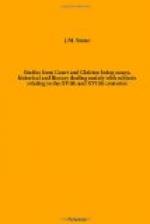That night the bishop dreamed he saw Sir Lancelot with two angels, “and he saw the angels heave up Sir Lancelot towards heaven, and the gates of heaven opened against him. And then they went to Sir Lancelot’s bed, and there they found him dead, and he lay as he had smiled; and the sweetest savour about him that ever they felt.”
III. FOXE’S BOOK OF ERRORS
To take the Acts and Monuments, and as far as it might be possible after upwards of three hundred years, test the accuracy of each circumstance which Foxe proposes for the edification of his readers, would necessitate a work as voluminous as his own immense undertaking. To sift the chaff from the wheat, and to bind up the latter into one acceptable whole would perhaps result in a book not larger than one of his own eight thick octavo and closely printed volumes. All that can be done here is to indicate some of the most flagrant instances of the unfair and uncritical spirit in which he has written, of the carelessness, wilful misrepresentation, and neglect to rectify errors pointed out to him, by which the martyrologist has exposed his book to everlasting reproach. On the death of Foxe’s last descendant the greater part of his MSS. were either given to the annalist, Strype, or were allowed to remain in his hands till his death in 1737, when many of them were purchased by Lord Oxford for the Harleian collection now in the British Museum. A few of them found a refuge in the Lansdowne Library, and these also are now in the possession of the nation. They include a mass of heterogeneous documents of the most unequal value and interest—such as the stories, often palpably coloured, of persons who profess to have been eye-witnesses of the scenes depicted, minutes of the examinations of prisoners, apparently taken down on the spot, wild statements written with the obvious purpose of pandering to Puritan intolerance and prejudice, and fantastic tales of the martyrologist’s supposed judgments of God upon those who persecuted the followers of the reformed doctrines. They include also several counter-statements sent to Foxe for the express purpose of giving him an opportunity to correct portions of his work, but of which, although he preserved them, he never made any use. Some of these latter have been utilised by Gough in his Narratives of the Days of the Reformation.
In his preface to this book, Gough admits,* as indeed he was obliged to admit that, “as a general history of the Church in its earlier ages, Foxes work has been shown to be partial and prejudiced in spirit, imperfect and inaccurate in execution,” and Leach** asserts that, while its compiler had recourse to some early documents, even here he depended largely on printed works, such as Crespin’s Actiones et Monuments Martyrum, which was published at Geneva in 1560. He notes, moreover, that Foxes chapter on the Waldenses is nothing but a translation of the




